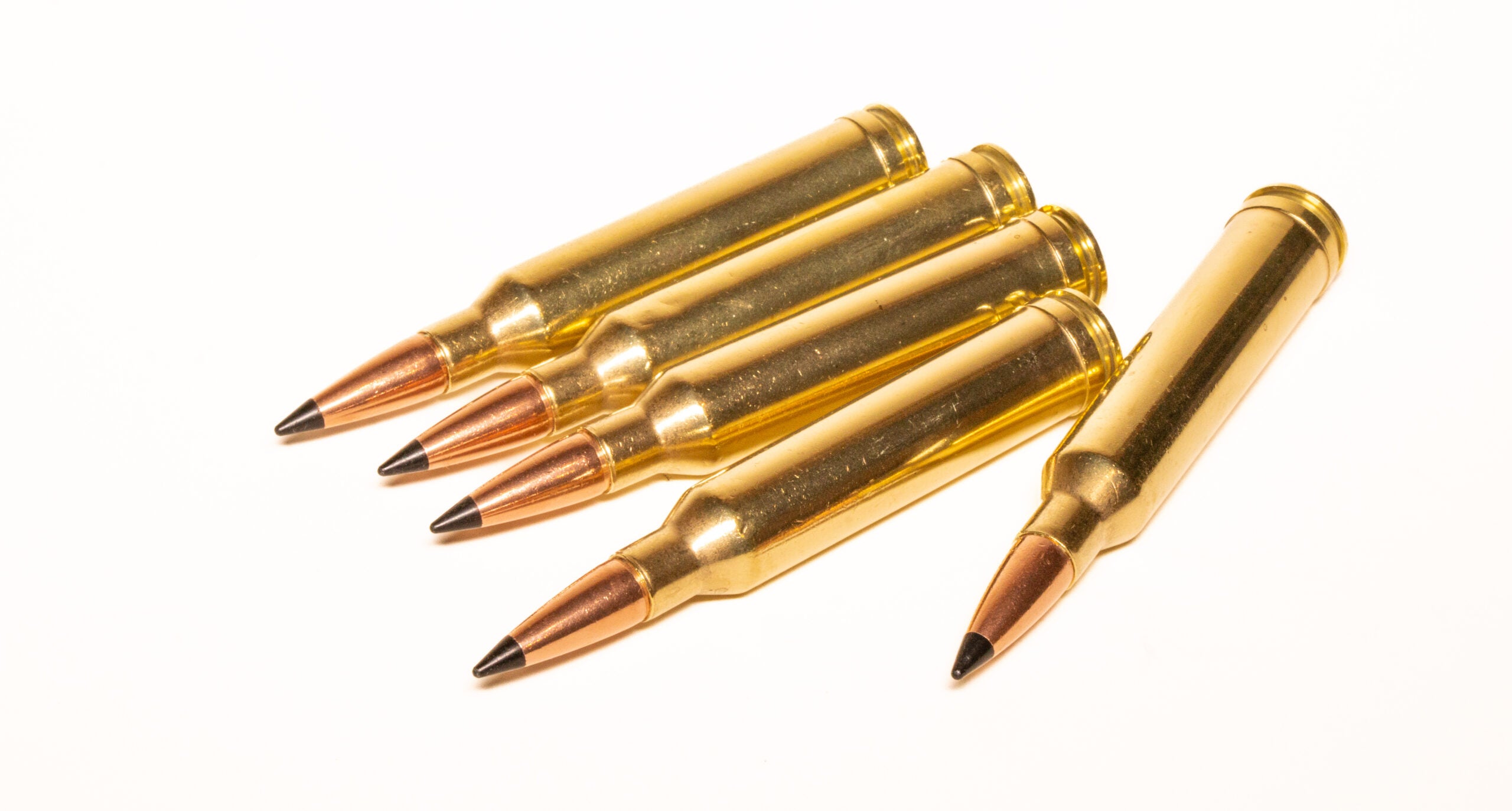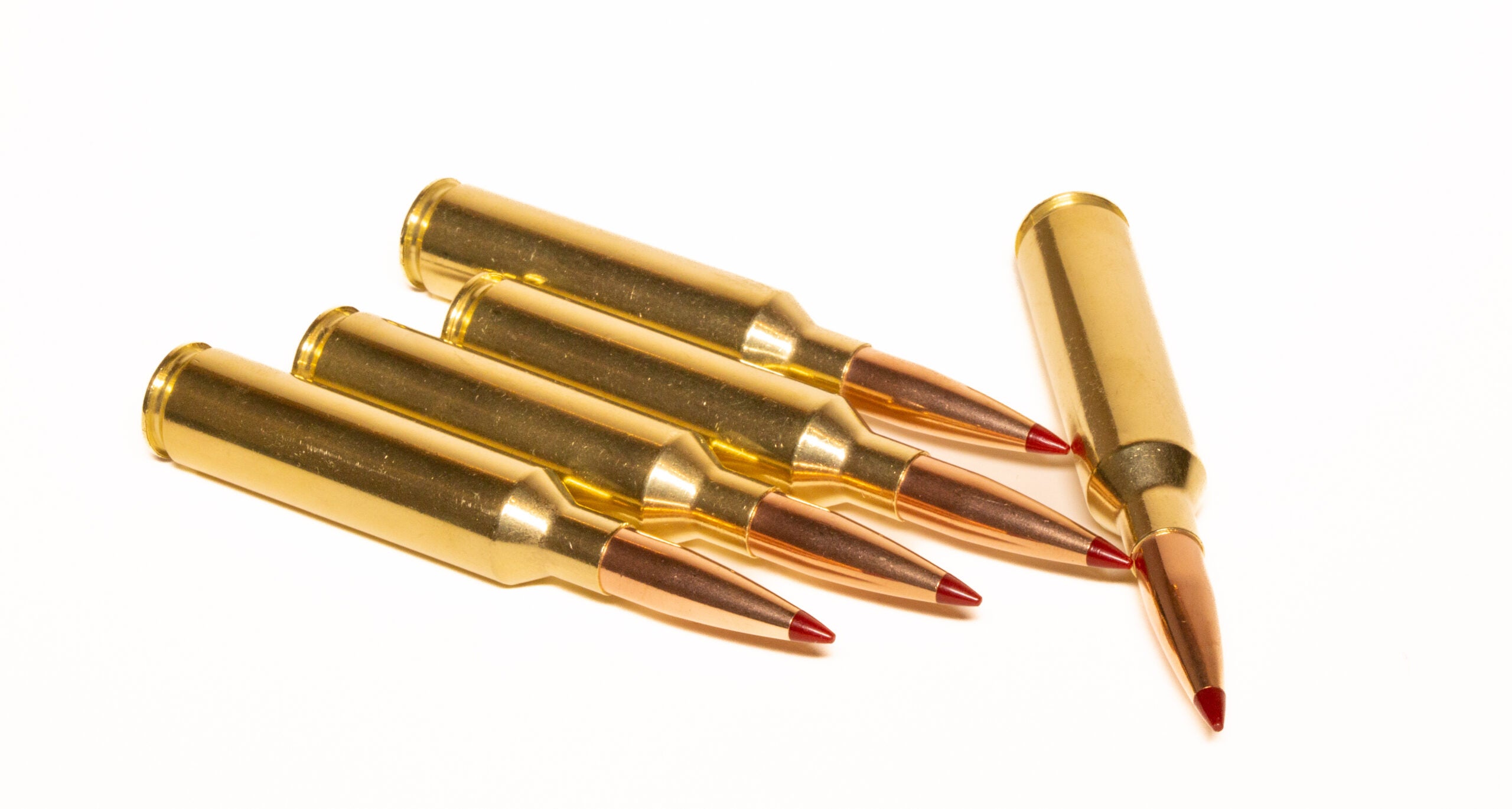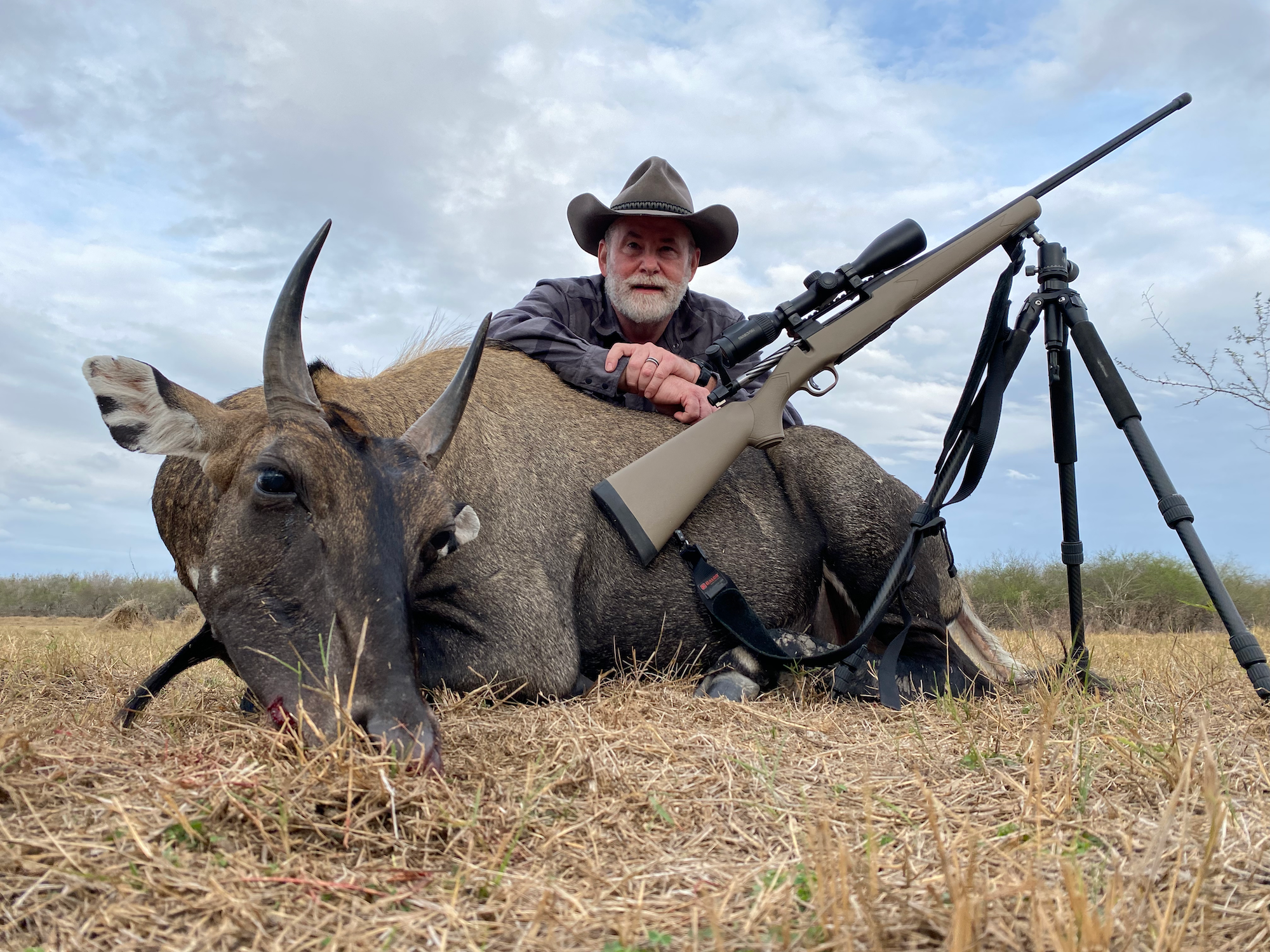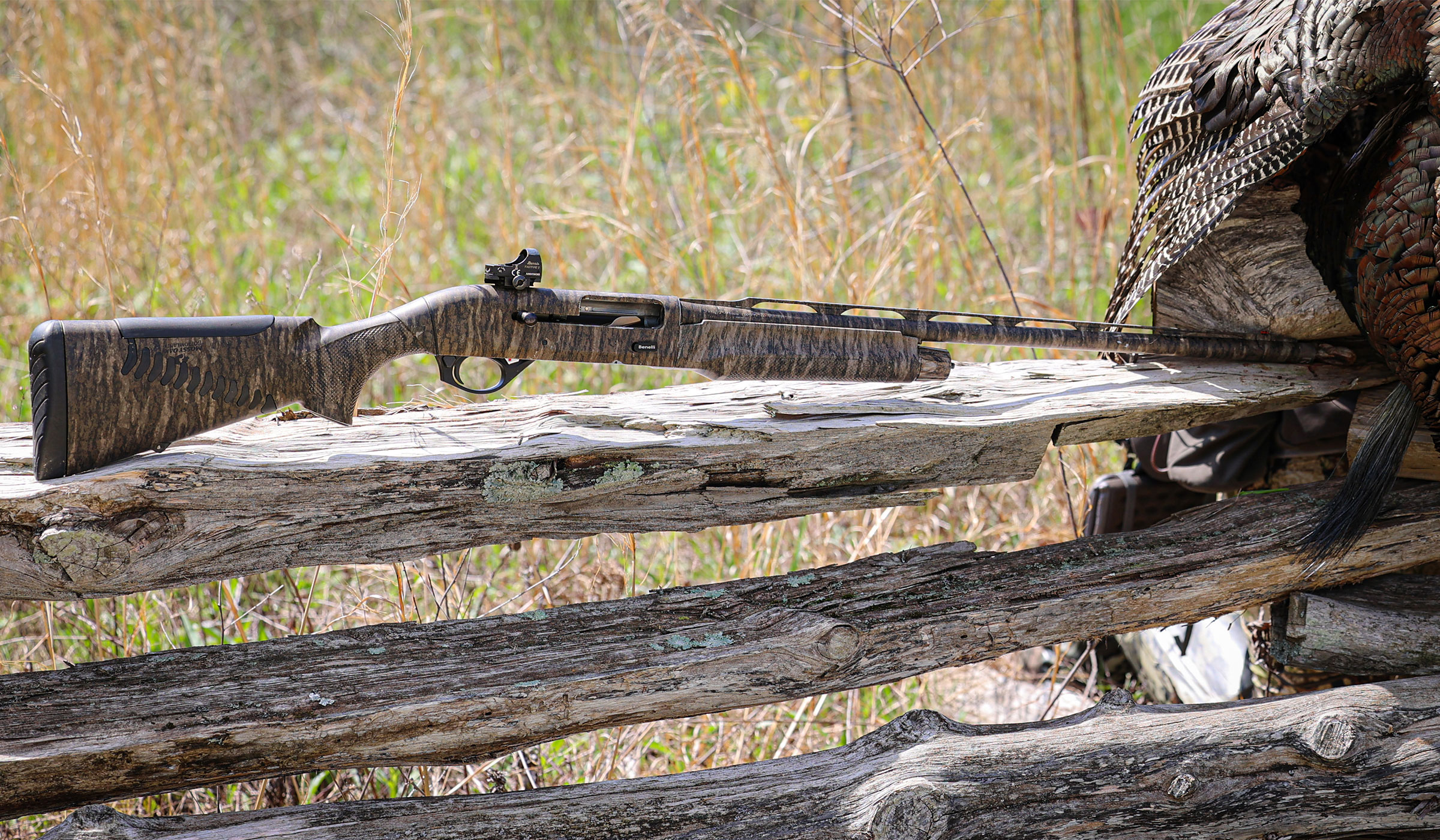We may earn revenue from the products available on this page and participate in affiliate programs. Learn more ›
The 7mm PRC vs. the 7mm Rem Mag comparison is one that a lot of shooters are wondering about. Some of the cartridge comparisons we do are like comparing apples to oranges, because the two cartridges are of a different caliber or power level. But they are comparisons that, for whatever reason, readers want to see. This comparison, on the other hand, is about as practical as you can get because both cartridges shoot the same diameter bullet, at about the same speed, and from a cartridge case that has about the same volume. The 7mm PRC is about 100 fps faster than the 7mm Rem Mag, but is it a better option?
Here’s everything you need to know about 7mm PRC vs 7mm Rem Mag, including ballistics, ammo availability, rifle availability, recoil and more. But first, let look at each one individually.
7mm Remington Magnum Overview

We’ll tackle the 7mm Remington Magnum first since it came first. Two factors made this cartridge an instant success. The first was that it was introduced in 1962 in conjunction with a new rifle from Remington called the Model 700. The Remington 700 would go on to be one of the most popular and respected bolt-action rifles ever manufactured. The second thing was the ballistics of the new cartridge. It outperformed the hugely popular 270 Winchester, and even Winchester’s new magnum, the 264 Winchester Magnum. In fact, in a very short time, the 7mm Remington Magnum pushed Winchester’s 264 out to pasture.
Remington’s famous Seven Mag is based on the 375 H&H Magnum, which is a belted Magnum cartridge. For years, the belt or rim of extra brass at the base of a cartridge is what made it a magnum in the eyes of most shooters. Some claim belted magnums won’t shoot with extreme precision, but some people also do not know what the hell they’re talking about. I had a 7mm Rem Mag from the Remington custom shop that shot groups so small it would make 6.5 Creedmoor lovers cry in public, and hitting steel at a mile with that rifle was just another day at the range.
When I was just a kid, my cousin had a 7mm Rem Mag, and it was the most wonderous but also hellaciously loud rifle I had ever seen. But what really set the 7mm Rem Mag apart from the crowd in 1962—and even today—is the amount of power and flatness of flight that it could deliver without intense recoil. Name another cartridge that can deliver 1000 foot-pounds of energy at 1000 yards with only 25 MOA or elevation correction from a 100 yard zero, while delivering only 20 foot-pounds of recoil energy out of a 9-pound, field-ready rifle…. I’m waiting.
Related: 7mm Rem Mag vs 300 Win Mag
7mm PRC Overview

Hornady has led the industry recently in modernizing rifle cartridges. This has mostly been done in three ways and by focusing on the bullet. The first was to use sharp 30° shoulder angles and reduce overall case length so that longer, higher-ballistic-coefficient bullets could be used. The next thing was to specify tight rifling twists rates to handle these long and slender bullets. And finally, to support these newly configured cartridge cases and fast twist rates, Hornady crafted bullets to go with them. This is how we’ve ended up with the 6.5 Creedmoor, 6.5 PRC, 300 PRC, 6.5 and 22 ARC, and the 7mm PRC.
The parent cartridge case for the 7mm PRC is the 300 PRC, but the 7mm PRC is not just a necked down 300 PRC. Hornady also shortened the cartridge case so that when loaded it would still work in rifle actions commonly used for the 7mm Rem Mag. The 7mm PRC actually has less powder capacity than the 7mm Rem Mag, but it’s the totality of the cartridge’s design, and the fact that it’s loaded to 65,000 psi, that gives it the slight ballistic advantage over the 7mm Remington Magnum.
I’ve killed three big game animals with the 7mm PRC. A big nilgia bull in Texas collapsed when hit, just like a big kudu bull in Limpopo did. The zebra I shot with the 7mm PRC ran less than 100 yards. I’ve also seen several other beasts taken with the 7mm PRC, and I can say, without hesitation, the 7mm PRC kills stuff—up close and at distance—just like a 7mm Remington Magnum.
7mm PRC vs 7mm Rem Mag Ballistics
There are some bullets loaded in factory ammunition for the 7mm PRC that are not offered for the 7mm Rem Mag. And in some cases, some of these bullets are a few grains heavier than those loaded for the 7mm Remington Magnum. That said, there are a few loads for both cartridges that use the same bullet, which is ideal when comparing the two cartridges. So, we’ll use one of those here—namely, the 155-grain Terminal Ascent load from Federal. This load perfectly illustrates the ballistic differences between these two cartridges. Here’s a quick rundown in chart from, followed my more detail below.

Velocity
With the Federal load, the 7mm PRC has a 100 fps velocity advantage. A bullet moving at a faster velocity gives gravity and wind less time to act upon it. That means its will shoot flatter and drift less. In the case of these two cartridges, that 100 fps muzzle velocity advantage equates to about 3 inches less drop at 500 yards, and about a ½ inch less wind drift. But given the fact that velocities will vary greatly from rifle to rifle, that 100 fps velocity advantage might not exist between certain rifles, or it could be slightly more. Either way, at practical hunting distances, if you hit or miss with a 7mm Remington Magnum, you’d likely do the same with a 7mm PRC.
Advantage: 7mm PRC, but very slight
Energy

Clearly, because the 7mm PRC has a velocity advantage, it will also have an energy advantage. But because bullet velocity is squared during the calculation of kinetic energy—and because the 7mm PRC is about 3% faster than the 7mm Remington Magnum—the kinetic energy difference between the two is more pronounced. At the muzzle, our 155-grain Terminal Ascent load creates about 210 more foot-pounds of kinetic energy out of the 7mm PRC than it does out of the 7mm Rem Mag. That’s about a 6% advantage, which is something, but not really enough to matter when you’re shooting a bull elk.
Advantage: 7mm PRC, also slight
Recoil
This is pretty simple. If you have two 9-pound field-ready rifles—one in 7mm PRC and one in 7mm Rem Mag—and they’re both loaded with the 155-grain Federal Terminal Ascent load (and if the muzzle velocities of those loads match Federal’s advertised velocities), the 7mm PRC rifle will recoil with about 23 foot-pounds of force. The 7mm Rem Mag rifle will recoil with 21.5 foot-pounds of force. The Seven Mag recoils about 6% less, which is unsurprisingly about the same as the difference in the energy at the muzzle. In other words, the difference in recoil between a 7mm PRC and a 7mm Remington Magnum, is about the same as the recoil from a 22 rifle. Remington’s Seven has a slight advantage, but only the most recoil sensitive will be able to realize it.
Advantage: 7mm Rem Mag, also slight
Ammo for the 7mm PRC and 7mm Rem Mag

A major on-line retailer lists 11 factory loads from five brands for the 7mm PRC, and they range in bullet weight from 155 to 180 grains. Interestingly, prices range from as about $2.80 per cartridge to as much as $8.75 (which works out to about $175 for box of 20 rounds.) That same on-line retailer lists 66 factory loads from 16 brands for the 7mm Rem Mag, with bullets ranging in weight from 139 to 180 grains, and cost-per-cartridge rates from as little as $1.50 per round to $4.50 per round. For handloaders none of this matters, but for everyone else, ammunition availability alone makes the 7mm Rem Mag the more versatile and affordable choice.
Advantage: 7mm Rem Mag
Rifles for the 7mm PRC and 7mm Rem Mag
The rifle cartridge you use matters, but outside of the extremes, it does not matter as much as your rifle. The rifle is what you as a shooter must interface with when you’re carrying it, shooting it, and caring for it. A rifle needs to fit you, and it needs to work, and finding a rifle that does those things well is more important than trying to decide between the 7mm PRC vs 7mm Rem Mag. I spent some time on-line shopping for a rifle in 7mm PRC, and I found 56 options from 10 different manufacturers. I also looked for rifles chambered for the 7mm Rem Mag and found 165 options from twice as many manufacturers. Granted, some of these rifles were identical, but with the Seven Mag, there was a much wider variety to choose from.
Advantage: 7mm Rem Mag
7mm PRC vs 7mm Rem Mag: Which Seven Is Right for You?

During the 60 plus years since its introduction, the 7mm Rem Mag has remained as the king of the 7mm cartridges. It kept the 7mm Weatherby at bay and staved off challenges from more modern cartridges like the 7mm Winchester Short Magnum, the 7mm STW, and even 7mm Remington Ultra Magnum, its short-action brother. It is, from a ballistics standpoint, just about a perfect balance of power, trajectory, and recoil. There’s a reason so many rifles have been chambered in it, and why there’s nearly 75 factory loads for it. The 7mm Rem Mag is not going anywhere.
The 7mm PRC is clearly ballistically superior, but to ever eclipse the 7mm Rem Mag in popularity, thousands of hunters would have to trade their beloved Seven Mags for a 7 PRC. I just don’t think that’s ever going to happen. However, just as the 7mm Rem Mag drastically cut into the sales and popularity of the 264 Winchester Magnum, I think that the rifle cartridge that will most feel pressure from the 7mm RPC is another, more modern, 0.264-caliber cartridge—the 6.5 PRC. Those wanting to stretch the distance with gravity defying, high-ballistic-coefficient bullets, will likely opt for the 7 PRC as opposed to the 6.5.
If you have a good-shooting 7mm Rem Mag you like, the biggest difference you’ll see with a new 7mm PRC is more expensive ammo. The load we used to compare the two cartridges costs 10% more in 7mm PRC than it does in 7mm Remington Magnum. If you’re looking to get a new rifle—maybe your first 7mm—the PRC is ballistically a little better, but right now there are only about a dozen loads to choose from. Maybe in another decade this will level out, but I feel that the 7mm PRC will ultimately only be more popular than the 7mm Rem Mag with long-range steel ringers. Why? Because it’s hard to dethrone a king!
Read Next: Best Rifle Cartridges for Elk Hunting
The post 7mm PRC vs. 7mm Rem Mag: Is the New Seven Better? appeared first on Field & Stream.
Articles may contain affiliate links which enable us to share in the revenue of any purchases made.
Read the full article here




